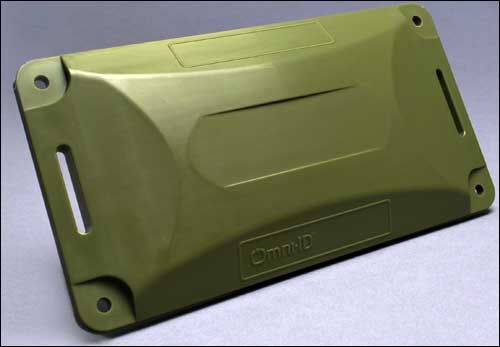Passive ultrahigh-frequency (UHF) RFID tag manufacturer Omni-ID has launched a new RFID platform to improve the performance of its EPC Gen 2 tags across a broader spectrum of UHF frequencies, as well as three new tags that use the platform to provide longer read ranges and higher reliability, regardless of where on Earth those tags are read. The new tags and platform, says Tom Pavela, Omni-ID’s president and CEO, will offer some of the longest read ranges yet achieved with passive tags—up to 35 meters (115 feet) in the case of one such tag. The offering will enable Omni-ID to market its UHF passive tags to industries that have historically opted for active RFID technology—namely, defense, transportation and manufacturing.
All three new tags—the Ultra, the Max HD and the Max Pro—are designed to perform well when attached to metal surfaces, Omni-ID reports. To enable the tags to perform consistently regardless of which UHF spectrum is used to interrogate them, the firm redesigned their “plasmonic structure”—a physical layer that the company incorporates into its tags to collect the RF signal received from an RFID reader and focus it on the tag’s RFID chip. The new plasmonic design will also be easier to manufacture, thus allowing the firm to respond more quickly to large customer orders.

Omni-ID has also built in a new coupling structure, consisting of the plasmonic layer and a near-field loop antenna attached to the chip, in order to enable the inlay to receive the RF energy reflected by the plasmomic structure. This new coupling structure, which is more durable and resistant to vibration than the previous version, will provide improved read ranges and performance, says Margie Kriebel, Omni-ID’s VP of marketing.
Global interoperability is important, Pavela notes, because RFID technology users are often international companies that ship cargo from one part of the world to another. EPC Gen 2 tags, he explains, often do not read with the same consistency from one region to the next due to differences in UHF RFID spectrum permitted by each nation’s regulatory agency. The new platform was designed to address that concern by offering consistent performance regardless of whether a tag is read in Asia, North America or Europe. The new tags are made with Alien Technology‘s Higgs 3 chips, thereby increasing the memory to 512 kilobytes, compared with the 240 kilobytes available in Omni-ID’s previously released tag models, which were manufactured with Alien’s Higgs 2 chip.
The Ultra is targeted for tracking containers, vehicles, cargo and other objects stored outdoors. Until now, such applications have largely needed to employ active RFID solutions. The Ultra has a read range up to 35 meters—the longest read range of any passive RFID tag on the market, Pavela indicates. The tag itself is large (measuring 8 inches by 5 inches), which helps it achieve such a long read range. The Ultra comes in a heavy-duty casing, to provide the durability required in outdoor environments, and has already been deployed by a major Tokyo theme park to track assets and work-in-progress (WIP).
The Max HD is smaller, measuring 5.5 inches long by 2.6 inches wide, and offers a rugged encasement for added durability and high heat resistance in applications where a tag is subject to high impact and extreme weather conditions. The tag has a maximum read range of 10 to 12 meters (33 to 39 feet), and is currently being used by the U.S. Marines to track heavy equipment and tools as they are transported globally.
The Max Pro, measuring 4.9 inches long by 2.3 inches wide, provides a 10-meter read range and is designed for retail warehouses and other indoor environments. Sam’s Club currently utilizes the tag to track bins storing products, with plans to employ the system at 600 stores throughout the United States. A European auto manufacturer (that asked to be unnamed) is piloting the tags at one of its engine manufacturing facilities, applying 3,000 Max Pro tags to containers in which the engines are packed.
Compared with the pricing of active tags, Pavela says, the new passive tags are inexpensive, with the Ultra costing between $6 and $10, the Max HD, $3 to $6, and the Pro, $2 to $4, depending on the quantities ordered. Omni-ID will continue offering its older tag models: the Max (priced at $1.50 to $3.88), the Flex ($1.35 to $3.50) and the Prox ($1.50 to $3).
“These tags are not intended to replace active tags,” Pavela explains, though in some cases, he notes, they do allow customers who have not used RFID due to the cost of battery-powered tags, to begin utilizing the less expensive passive solution. According to Pavela, Omni-ID’s new offerings are in response to a continued growth the company sees in the size and quantity of tag orders. “We’re seeing continued growth in RFID, even in this economy,” he says. To help meet the demand for its products, the firm recently opened a manufacturing site in China (see Omni-ID to Open Production Plant in China).

